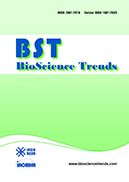Volume 13, Issue 2
Displaying 1-14 of 14 articles from this issue
- |<
- <
- 1
- >
- >|
Policy Forum
-
Article type: research-article
2019 Volume 13 Issue 2 Pages 110-116
Published: April 30, 2019
Released on J-STAGE: May 12, 2019
Advance online publication: April 20, 2019Download PDF (427K)
Review
-
Article type: review-article
2019 Volume 13 Issue 2 Pages 117-129
Published: April 30, 2019
Released on J-STAGE: May 12, 2019
Advance online publication: March 31, 2019Download PDF (448K)
Original Articles
-
Article type: research-article
2019 Volume 13 Issue 2 Pages 130-135
Published: April 30, 2019
Released on J-STAGE: May 12, 2019
Advance online publication: March 29, 2019Download PDF (1046K) -
Article type: research-article
2019 Volume 13 Issue 2 Pages 136-144
Published: April 30, 2019
Released on J-STAGE: May 12, 2019
Advance online publication: March 29, 2019Download PDF (430K) -
Article type: research-article
2019 Volume 13 Issue 2 Pages 145-151
Published: April 30, 2019
Released on J-STAGE: May 12, 2019
Advance online publication: April 16, 2019Download PDF (1752K) -
Article type: research-article
2019 Volume 13 Issue 2 Pages 152-159
Published: April 30, 2019
Released on J-STAGE: May 12, 2019
Advance online publication: April 11, 2019Download PDF (631K) -
Article type: research-article
2019 Volume 13 Issue 2 Pages 160-167
Published: April 30, 2019
Released on J-STAGE: May 12, 2019
Advance online publication: April 02, 2019Download PDF (2027K) -
Article type: research-article
2019 Volume 13 Issue 2 Pages 168-175
Published: April 30, 2019
Released on J-STAGE: May 12, 2019
Advance online publication: April 08, 2019Download PDF (429K) -
Article type: research-article
2019 Volume 13 Issue 2 Pages 176-181
Published: April 30, 2019
Released on J-STAGE: May 12, 2019
Advance online publication: April 27, 2019Download PDF (535K) -
Article type: research-article
2019 Volume 13 Issue 2 Pages 182-188
Published: April 30, 2019
Released on J-STAGE: May 12, 2019
Advance online publication: April 27, 2019Download PDF (393K) -
Article type: research-article
2019 Volume 13 Issue 2 Pages 189-196
Published: April 30, 2019
Released on J-STAGE: May 12, 2019
Advance online publication: April 24, 2019Download PDF (509K)
Brief Reports
-
Article type: research-article
2019 Volume 13 Issue 2 Pages 197-203
Published: April 30, 2019
Released on J-STAGE: May 12, 2019
Advance online publication: April 25, 2019Download PDF (908K) -
Article type: research-article
2019 Volume 13 Issue 2 Pages 204-211
Published: April 30, 2019
Released on J-STAGE: May 12, 2019
Advance online publication: April 24, 2019Download PDF (2340K) -
Article type: research-article
2019 Volume 13 Issue 2 Pages 212-215
Published: April 30, 2019
Released on J-STAGE: May 12, 2019
Advance online publication: April 15, 2019Download PDF (333K)
- |<
- <
- 1
- >
- >|
